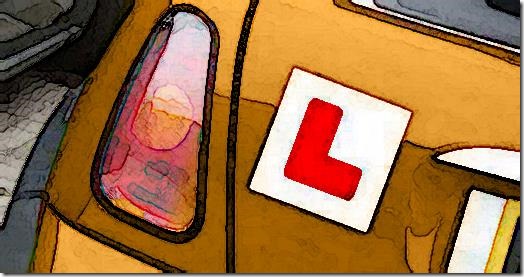 I first published this back in 2012 after someone had found the blog on precisely that search term!
I first published this back in 2012 after someone had found the blog on precisely that search term!
Passing the driving test is a skills-based event, so probability doesn’t come into it – not in any way that could be manipulated or measured, anyway. But I had another one recently come to the blog via the term “the probability that a person passes their driving test is 75%”.
The problem here is that people get probability and statistics mixed up – and they don’t understand either.
Every test centre has a pass rate. These are all statistics – measurements of what has actually taken place – and any given test centre might have a pass rate anywhere from under 30% all the way up to 80% or more. Why is this?
 Take Mallaig in Scotland, for example. It is a tiny fishing village in the middle of nowhere. It has something like 10km of roads in total, no dual carriageways, one roundabout, a total population of about 1,000, and is 140 miles away from the nearest motorway (it’s actually only a few miles north west from the place where Connor MacLeod was born in Highlander). In the business year 2017/18 a total of 21 tests were conducted at the test centre there, with a pass rate of 71%. In contrast, Nottingham has three test centres, and between them there were over 20,000 tests conducted during the same period, with a pass rate of about 45%. Nottingham has a population of over a quarter of a million, lots of dual carriageways and complex roundabout systems, a busy city centre, and protracted rush hours vying with overrunning roadworks and ever-changing road restrictions. Similarly, Bradford’s three test centres conducted around 15,000 tests, even though it has a slightly larger population than Nottingham and similar types of roads. However, one of its test centres had a pass rate of just 37% in the same period.
Take Mallaig in Scotland, for example. It is a tiny fishing village in the middle of nowhere. It has something like 10km of roads in total, no dual carriageways, one roundabout, a total population of about 1,000, and is 140 miles away from the nearest motorway (it’s actually only a few miles north west from the place where Connor MacLeod was born in Highlander). In the business year 2017/18 a total of 21 tests were conducted at the test centre there, with a pass rate of 71%. In contrast, Nottingham has three test centres, and between them there were over 20,000 tests conducted during the same period, with a pass rate of about 45%. Nottingham has a population of over a quarter of a million, lots of dual carriageways and complex roundabout systems, a busy city centre, and protracted rush hours vying with overrunning roadworks and ever-changing road restrictions. Similarly, Bradford’s three test centres conducted around 15,000 tests, even though it has a slightly larger population than Nottingham and similar types of roads. However, one of its test centres had a pass rate of just 37% in the same period.
In 2012, Bradford – well, one of the test centres there – was highlighted as having the worst pass rate in the country at less than 30%. Bradford’s problem at that location is that there’s a high sub-population of non-UK nationals. As unpalatable as it might be to the politically correct mob, non-UK provisional licence holders have a tendency to want to go to test before they’re ready, and they will often do it in their own cars without ever having had any formal training in the UK. And they do it again, and again, and again, test after test, with no training in between tries. All large cities have this problem one way or another.
I’ve got just such a pupil right now. There is no way I would ever let him go to test using my car the way his driving is, and I have told him he needs more lessons before he tries again. But he won’t listen, and keeps going in his own car after taking a single hour with me each time. It’s hard to put this into words, but he hasn’t got a bloody clue how to do even the simplest of roundabouts, and when he encounters one with lanes marked on it the lines may as well not be there. In fact, in his head, they aren’t there. As soon as he realises it’s a roundabout he panics and – poof! – the lanes just vanish as far as he’s concerned. He is in his 30s and has driven for many years in one of those places where you are “able to drive” if you can put your head down and accelerate into heavy traffic and weave around hundreds of others all doing the same. It’s also one of those places where the men will never admit that they can’t do something, even when it is completely obvious to everyone – including them – that they can’t. He simply cannot get it into his head that he hasn’t got a cat in hell’s chance of passing his test until he sorts this out. But he’s got another one booked even now.
DVSA actually publishes pass rate data by ethnicity – something which surprises me, given the risks of misinterpreting the data to suit personal agendas – and if you look at the lowest rated Bradford test centre, the pass rate among those identifying as Asian or British Asian and Black or British Black is 34.5% whereas among those identifying as White it is 47%. You have the same skew in Nottingham under those same headings, and pretty much everywhere else. It’s a big difference, and although the data don’t go into finer detail, I would lay money that it is the non-British element within those groups which is pulling the figures down. Where the ratio of non-UK to UK is higher in any given community, the overall pass rate in the location covered by that test centre is so much lower.
Non-British Asian/Black people taking tests tend to be older, have families to support, have low-paid jobs (carers or security, for example), are desperate to get a licence to improve their prospects, and are isolated from their larger family and have no financial backup beyond their wages. They also tend to have many years’ previous experience of driving – albeit badly – and believe they are capable of passing the test over here. Habits are deeply ingrained. Whites tend to be 17-24 year olds who are only learning to drive because its the next thing they need to do in their lives, who haven’t driven much before (if at all) and so don’t have habits to break, who probably won’t get a car for the next year or two anyway, and who can often sponge off mummy and daddy for the lesson fees. It’s not a clear cut division, but it is the tendency nonetheless. And that affects the statistics.
You can already see how complicated this is. A test centre’s pass rate is meaningless except for comparing that centre’s performance over time, and it has no clear bearing on the rates from other centres in other parts of the country because other factors are involved. For example, Bradford’s apparent “improvement” since 2012 is highly likely to have been a deliberate manipulation to make it look better following the bad press it received back then. As an illustration, Mallaig’s pass rate could go up to 90% or fall to 20%, but that would not affect Nottingham’s statistics unless the change were the result of something which affected everyone in the UK, and in a quantifiable manner. I mean, imagine DVSA adding a motorway element to the test. Mallaig’s nearest motorway is further away than London is from Nottingham, so they couldn’t possibly do it, but test centres like Nottingham Watnall and Chilwell – which are both right next to the M1 – would see it affect on their pass rates.
 Statistics are a statement of what did happen. They are not probabilities – a prediction of what will happen.
Statistics are a statement of what did happen. They are not probabilities – a prediction of what will happen.
If someone takes a driving test having never driven before, and never having had any lessons, they will fail – no matter what their test centre’s pass rate is. Statistically, the centre could have a 100% pass rate, but someone who can’t drive has a 0% probability of passing. It follows logically that even if someone has had lessons, unless they’ve had enough to make them good enough they will still fail. Only when they have had enough training to make it possible for them to pass a test does probability enter into the equation – but even then it is still not something you can assign a definite number to, because so much depends on nerves, road conditions, events on the day, and so on.
All you can say is that if a candidate can drive to an acceptable standard, and doesn’t do anything stupid on their test (for whatever reason), there is a high probability of them passing. That probability is much higher than the pass rate at the test centre they’re using, but definitely much less than 100%.
If they can’t drive to an acceptable standard, the probability of them passing is close to 0%.
DVSA is not looking for perfect drivers who don’t make any mistakes. The criterion they are using is that the test candidate should be safe enough to drive unsupervised so that they can then gain more and more experience over time.
What are the chances of passing a driving test?
If you can’t drive, they’re approximately zero – you have no chance whatsoever. If you’re a good driver, your chances are very high. It’s that simple.
So my chances are better if I take one or two lessons?
If you can’t drive well enough to pass the test during those lessons, your chances of passing a real one are still almost zero.
Take the parallel park exercise as an example. If you can’t do it during lessons, you’re not going to be able to do it on the test. The same goes for every other aspect of driving that might result in a serious fault on test if you don’t do it properly.
What are the chances of passing my driving test after failing the first time?
Your chances of passing have nothing to do with your previous attempts. If you can drive without your instructor intervening on lessons, you’ll probably pass your test. If you can’t, then you will probably fail it.
Too many people go for their test before they are ready – especially when they’re desperate for a UK drivers licence. Some think they’re ready, some want to be ready, and some just don’t want to (or can’t) spend any more money. Then they fail.
If you’re not ready you will fail. Even if your dream came true and you scraped a pass, you’d be dangerous on the roads.
Yes, but what are my chances of passing second time?
Exactly the same as they were the first time if you still can’t drive properly.
I can drive, so why did I fail?
Assuming that you really can drive, it might just have been a bit of bad luck on the day – some other road user doing something you didn’t expect, or that you’d never had to deal with before. It happens.
However, a lot of learners mistakenly believe that they are better than they are. Many take their tests based on how many hours of lessons they’ve had (in turn, based on how much they could afford). The risk of failing is much higher if you approach your test that way.
What is the best time of year to take your driving test?
There isn’t one, any more than there’s a “best time of day” to take it. If you can drive – and don’t make any serious mistakes – you will pass, whether it’s at Christmas or in summer, morning or afternoon.
What are the statistics that somebody will pass their driving test 2nd time?
That term has been used to find this article. If you can’t drive properly, your “chances” are exactly the same as they were the first time. Passing the test is about ability, not chance.
What are the chances of passing the driving test third time?
That term has been used to find this article. The simple answer is that your chances of passing your test are the same every time you take it if you assume that your ability remains constant. If you get better at driving, your chances increase, but they only become “good” once you can drive well.
The likelihood of passing your driving test is based on your ability, not probability. People who fail at their first attempt are usually better prepared for the second. However, some people are simply not prepared at all and are just gambling on scraping through every time.
If the probability of passing your test is 75%, what is the probability of passing in under four attempts?
Someone found the blog on that search term. I suspect it is a maths question rather than a driving one, but I will answer it as though it were the latter.
Passing your test is not based on probability. If you can’t drive, then you have no chance of passing, and the probability is effectively zero. As your driving ability improves, so does the probability that you will pass. However, it is impossible to put a number to driving ability such that the probability of passing can be calculated, and even if you could, you’d then have to factor in other equally unmeasurable numerical representations of any number of unpredictable events on the day of your test which could shift your chances of passing either up or down the scale.
Just for the record, and as I’ve just explained, the probability of passing your test is not 75% in the first place. And whatever the outcome of your first attempt, that has no measurable bearing on what happens on subsequent tests. It is quite possible to only just fail one test, then fail miserably on one or more of your following attempts.
Generally, most people do improve between tests, but so many other variables are involved that general improvement in the candidate’s ability might not show up as a reduction in driver faults. I’ve seen people fail with perhaps two faults – one of which is a serious – and then pass their next attempt with maybe 9 driver faults.
Does everyone have the same chance of passing their test?
Everyone has the same opportunity to pass – they’re all being tested to the same standard. However, everyone is different, with different abilities, and success in the test is governed by ability.
Since I’ve been doing this job I have encountered people who, quite frankly, should be prevented by Law from ever going near a car. Frighteningly, I know of at least three of them who have passed their tests – one of those has had numerous minor accidents related to emerging without looking properly, and another did so much damage to her car in the fortnight she owned it by keep reversing into her gate post (three times that I know of) that she has given up driving and got rid of the car.
Aren’t you at fault for teaching these people to drive?
Believe me, I think about that all the time. I wish that we were allowed to tell people that they should give up the idea of driving. I have my own way of dealing with it – but I know that they just go and find someone who will carry on teaching them, and they take test after test until they pass.
I had a guy a couple of years ago who failed five tests with me (he’d failed several before). He refused to do more than a single one hour lesson before each attempt because he’d already “spent enough”. He argued that he failed on something different every time, and so all he had to do was not make that same mistake again and he’d be all right. He wouldn’t accept my explanation that his “different” mistakes were due to the same underlying issue, which if dealt with would increase the likelihood of him passing. That was in January 2014, and it was the last I saw of him. Well, until November 2014, that is, when I saw him coming out of the test centre as I was going in with a huge grin on his face. While he was with me, he spent £230 on lessons and £310 on tests over three months – pro rata, he would have spent a further £500-£800 in tests by the time I saw him nine months later in November.
This is how these people are. You can’t tell them directly that they can’t drive. And even if you did, someone would still teach them.